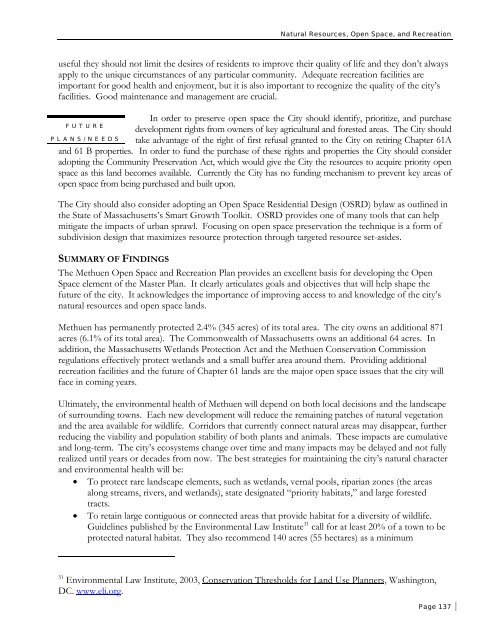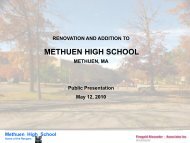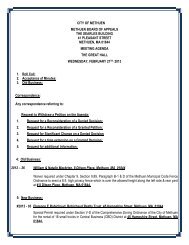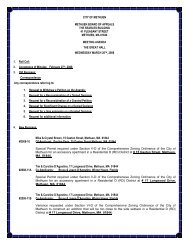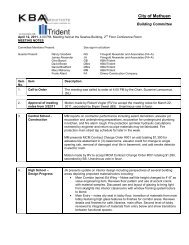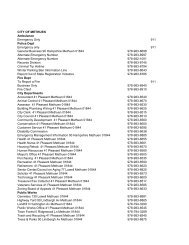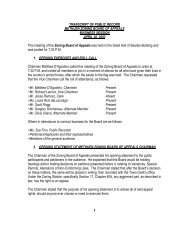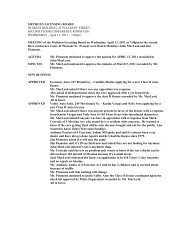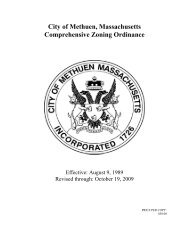City of Methuen Master Plan
City of Methuen Master Plan
City of Methuen Master Plan
Create successful ePaper yourself
Turn your PDF publications into a flip-book with our unique Google optimized e-Paper software.
Natural Resources, Open Space, and Recreation<br />
useful they should not limit the desires <strong>of</strong> residents to improve their quality <strong>of</strong> life and they don’t always<br />
apply to the unique circumstances <strong>of</strong> any particular community. Adequate recreation facilities are<br />
important for good health and enjoyment, but it is also important to recognize the quality <strong>of</strong> the city’s<br />
facilities. Good maintenance and management are crucial.<br />
In order to preserve open space the <strong>City</strong> should identify, prioritize, and purchase<br />
FUTURE<br />
development rights from owners <strong>of</strong> key agricultural and forested areas. The <strong>City</strong> should<br />
take advantage <strong>of</strong> the right <strong>of</strong> first refusal granted to the <strong>City</strong> on retiring Chapter 61A<br />
and 61 B properties. In order to fund the purchase <strong>of</strong> these rights and properties the <strong>City</strong> should consider<br />
adopting the Community Preservation Act, which would give the <strong>City</strong> the resources to acquire priority open<br />
space as this land becomes available. Currently the <strong>City</strong> has no funding mechanism to prevent key areas <strong>of</strong><br />
open space from being purchased and built upon.<br />
PLANS/NEEDS<br />
The <strong>City</strong> should also consider adopting an Open Space Residential Design (OSRD) bylaw as outlined in<br />
the State <strong>of</strong> Massachusetts’s Smart Growth Toolkit. OSRD provides one <strong>of</strong> many tools that can help<br />
mitigate the impacts <strong>of</strong> urban sprawl. Focusing on open space preservation the technique is a form <strong>of</strong><br />
subdivision design that maximizes resource protection through targeted resource set-asides.<br />
SUMMARY OF FINDINGS<br />
The <strong>Methuen</strong> Open Space and Recreation <strong>Plan</strong> provides an excellent basis for developing the Open<br />
Space element <strong>of</strong> the <strong>Master</strong> <strong>Plan</strong>. It clearly articulates goals and objectives that will help shape the<br />
future <strong>of</strong> the city. It acknowledges the importance <strong>of</strong> improving access to and knowledge <strong>of</strong> the city’s<br />
natural resources and open space lands.<br />
<strong>Methuen</strong> has permanently protected 2.4% (345 acres) <strong>of</strong> its total area. The city owns an additional 871<br />
acres (6.1% <strong>of</strong> its total area). The Commonwealth <strong>of</strong> Massachusetts owns an additional 64 acres. In<br />
addition, the Massachusetts Wetlands Protection Act and the <strong>Methuen</strong> Conservation Commission<br />
regulations effectively protect wetlands and a small buffer area around them. Providing additional<br />
recreation facilities and the future <strong>of</strong> Chapter 61 lands are the major open space issues that the city will<br />
face in coming years.<br />
Ultimately, the environmental health <strong>of</strong> <strong>Methuen</strong> will depend on both local decisions and the landscape<br />
<strong>of</strong> surrounding towns. Each new development will reduce the remaining patches <strong>of</strong> natural vegetation<br />
and the area available for wildlife. Corridors that currently connect natural areas may disappear, further<br />
reducing the viability and population stability <strong>of</strong> both plants and animals. These impacts are cumulative<br />
and long-term. The city’s ecosystems change over time and many impacts may be delayed and not fully<br />
realized until years or decades from now. The best strategies for maintaining the city’s natural character<br />
and environmental health will be:<br />
• To protect rare landscape elements, such as wetlands, vernal pools, riparian zones (the areas<br />
along streams, rivers, and wetlands), state designated “priority habitats,” and large forested<br />
tracts.<br />
• To retain large contiguous or connected areas that provide habitat for a diversity <strong>of</strong> wildlife.<br />
Guidelines published by the Environmental Law Institute 31 call for at least 20% <strong>of</strong> a town to be<br />
protected natural habitat. They also recommend 140 acres (55 hectares) as a minimum<br />
31<br />
Environmental Law Institute, 2003, Conservation Thresholds for Land Use <strong>Plan</strong>ners, Washington,<br />
DC. www.eli.org.<br />
Page 137


